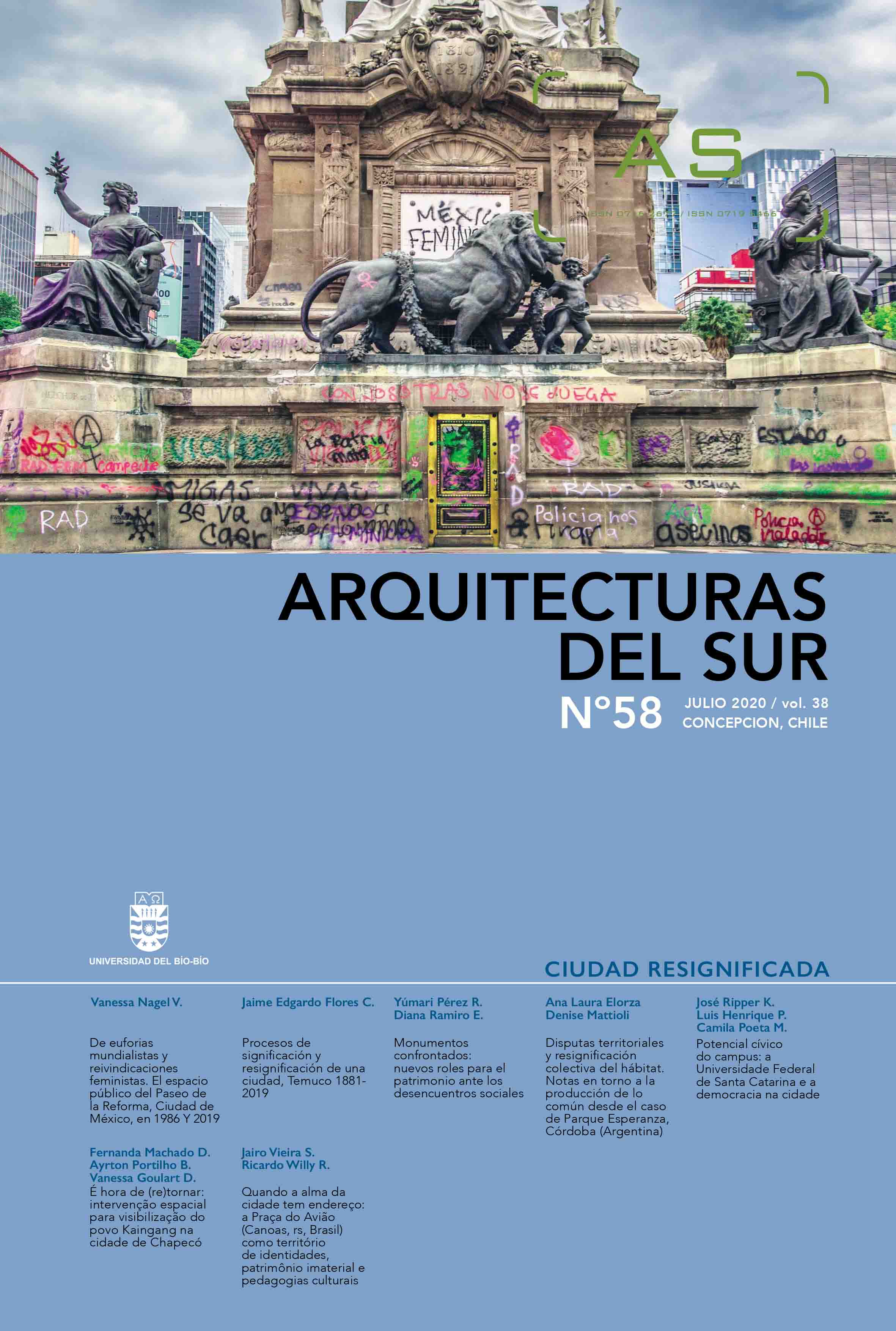The civic potential of the campus: Federal University of Santa Catarina and democracy in the city
DOI:
https://doi.org/10.22320/07196466.2020.38.058.05Keywords:
public space, university campuses, citizenship, social infrastructure, democracyAbstract
This article advocates the potential space for promoting public democratic environments. In recent decades, public university policies in Brazil have provided an expressive shift towards more inclusive campuses. On the other hand, the growing urban commercialization has significantly reduced diversity within the city’s public areas. This study aims to highlight the relevant role that university campuses can play in providing civic areas for the city and to evaluate the spatial characteristics that facilitate democratic gatherings. In 2019, the Federal University of Santa Catarina’s main campus was the stage of several events to protest against the government’s reduction of the education budget. The study starts from the recognition of the university areas that house students from more diverse areas of study. Subsequently, university community assemblies have been registered within this area and their spatial attributes have been analyzed. More flexible and permeable spaces on the buildings’ ground floor influenced these choices to gather and confront ideas. These findings point to solutions that go against current practices, aimed towards more protected entrances. Furthermore, they suggest directions so the university reduces its boundaries, inviting the city into its open areas through buildings that offer free services to its citizens.
Downloads
References
ALMEIDA PINTO, G., & BUFFA, E. (2009). Arquitetura e educação: câmpus universitários brasileiros. EdUFSCar.
BRASIL. (2014). A democratização e expansão da educação superior no país 2003-2014.
BRASIL. (2016). Proposta de Emenda à Constituição n° 55, de 2016.
BRENNER, N., MARCUSE, P., & MAYER, M. (2009). Cities for people, not for
profit. City, 13 (2-3), 176-184. https://doi.org/10.1080/13604810903020548
CASTELLS, M. (2015). Networks of outrage and hope: Social movements in the Internet age. New Jersey: John Wiley & Sons.
CHAPMAN, M. P. (2006). American Places: In Search of the Twenty-First Century Campus. ACE/Praeger Series on Higher Education. Westport: Greenwood Press.
DOBER, R. P. (1992). Campus design. New York: Wiley.
GASPAR, J. V., MENEGAZZO, C., FIATES, J. E., TEIXEIRA, C. S., & GOMES, L. S.R. (2017). A revitalização de espaços urbanos: O case do Centro Sapiens em Florianópolis. Revista Livre de Sustentabilidade e Empreendedorismo, 2(4), 183-205
GOTHAM, K. F. (2005). Theorizing urban spectacles. Festivals, tourism and the transformation of urban space. City, 9(2), 225–246. https://doi.org/10.1080/13604810500197020
HARVEY, D. (2003). The right to the city. International journal of urban and regional research, 27(4), 939-941. https://doi.org/10.1111/j.0309-1317.2003.00492.x
KLINENBERG, E. (2018). Palaces for the people: How social infrastructure can help fight inequality, polarization, and the decline of civic life. New York: Broadway Books.
LEFEBVRE, H., KOFMAN, E., & LEBAS, E. (1996). Writings on cities (Vol. 63). Oxford: Blackwell.
MANGRICH C. P., PAVAN L. H., GOMES F., OLIVEIRA L., KOS J., MARTINA J. E. (2019). Campus regenerative design supported by university Wi-Fi connections. In International Journal of Architectural Computing (pp. 206-219). https://doi.org/10.1177/1478077119849682.
PARKINSON, J. (2006). Holistic democracy and physical public space. In British Journal of Political Science Conference (pp. 1-17). British Academy. PARKINSON, J. (2012). Democracy and public space: The physical sites of democratic performance. Oxford: Oxford University Press.
PARKINSON, J. (2013). How is space public? Implications for spatial policy and democracy. Environment and Planning C: Government and Policy, 31(4), 682-699. https://doi.org/10.1068%2Fc11226r
PASSOS, J. C. D. (2015). Relações raciais, cultura acadêmica e tensionamentos após ações afirmativas. Educação em Revista, 31(2), 155-182. https://doi.org/10.1590/0102-4698134242
PEREIRA, F. T. B. (2017). Exporting progress: os norte-americanos e o planejamento do campus no Brasil. Doctoral Thesis, Instituto de Arquitetura e Urbanismo, University of São Paulo, São Carlos. doi:10.11606/T.102.2017.tde-04092017-105123.
SCHÖLLMANN, A., PERKINS, H. C., & MOORE, K. (2000). Intersecting global and local influences in urban place promotion: The case of Christchurch, New Zealand. Environment and Planning A, 32(1), 55–76. https://doi.org/10.1068%2Fa31185.
SUNSTEIN, C. R. (2018). # Republic: Divided democracy in the age of social media. Princeton University Press.
TEIXEIRA, L. E. F. (2009). Arquitetura e cidade: a modernidade (possível) em Florianópolis, Santa Catarina-1930-1960 (Doctoral dissertation, Universidade de São Paulo).
TEIXEIRA, L., YUNES, G., SOUZA, R., SANSÃO, M., & GODOY, M. (2014). Um itinerário para a arquitetura moderna em Florianópolis. Cadernos NAUI, 3(4).
Downloads
Published
How to Cite
Issue
Section
License
Copyright (c) 2020 José Ripper-Kos; Luis Henrique Pavan; Camila Poeta-Mangrich

This work is licensed under a Creative Commons Attribution-ShareAlike 4.0 International License.
The content of the articles published in each issue of Arquitecturas del Sur is the sole responsibility of the authors and does not necessarily represent the opinion of University of the Bío-Bío.
The authors will maintain their copyright; however, they will guarantee the journal the right to first publication and dissemination of their work. The publication of the article in Arquitecturas del Sur will be subject to the Creative Commons International license (CC BY-SA) that allows others to adapt: remix, transform and build on the material for any purpose, even commercially; share: copy and redistribute the material in any medium or format, as long as the authorship and first publication in this journal are acknowledged by citing them correctly, and their new contributions are under a license with the same terms.














 Programa de Información Científica/Concurso Fondos de Publicación de Revistas Científicas 2018/ Proyecto Mejoramiento de Visibilidad de Revistas UBB (Código:FP180007)
Programa de Información Científica/Concurso Fondos de Publicación de Revistas Científicas 2018/ Proyecto Mejoramiento de Visibilidad de Revistas UBB (Código:FP180007) 
